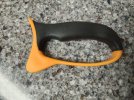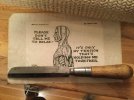That's essentially why I phrased it the way I did ('whether or not'). In the hands of some true masters, it really can be an art in the beauty of it. For others of us, including myself, it may simply be more utilitarian - including anything up to and including literal shaving sharpness, but maybe not as 'pretty' in the finished visual.
I agree that some won't see the need for learning with a guided system and have learned some other way. But that's what worked for me. Everybody's learning curve is different. The way I started out, in seeing just what 'sharp' could be as first demo'd by my use of a guided rig, that's what motivated me to emulate the same degree of sharpness in my freehand attempts at it. It set a target to aim for. Today, my freehand edges are at least as sharp as what I first achieved on the guided rigs I used. And even better in some aspects, like figuring out what sort of edge finish or profile is best for the specific task I want to perform. In particular, the slight convex behind the edge resulting from freehand sharpening usually performs better in cutting tougher materials, where the otherwise crisp shoulders on a perfect V-edged profile would be more prone to bind up in cutting tough materials. My favorite edges these days all have some shallow convex to the grind behind the edge.



